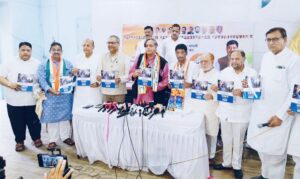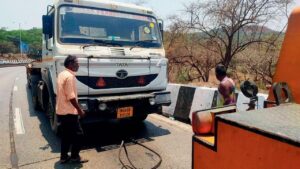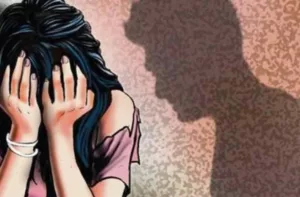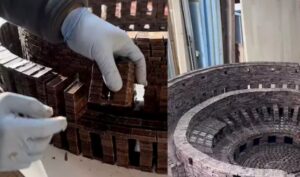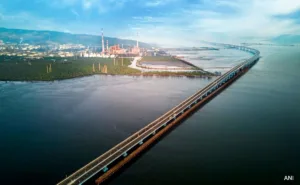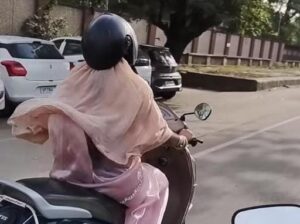How did Pune get so messed up ?
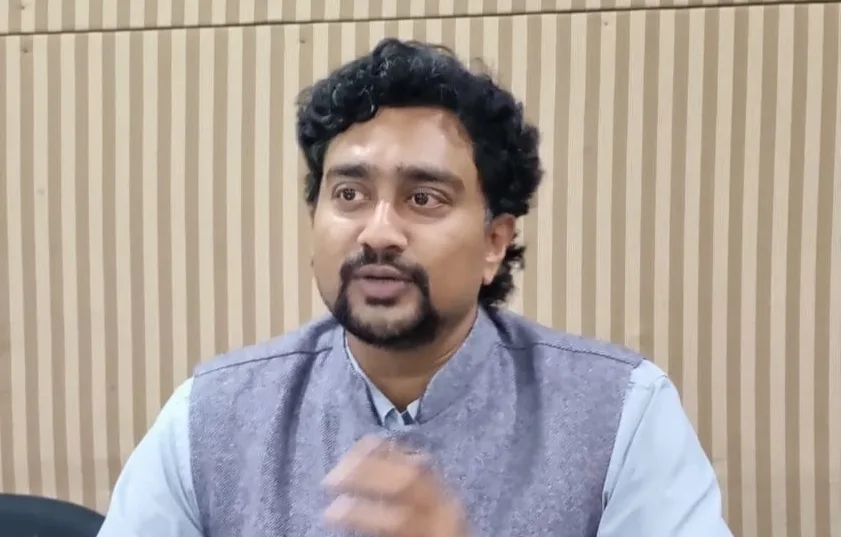
How did Pune get so messed up ?
Renowned media personality RJ Sangram Khopade has released “MH 12 che 12 kase vajle” meaning how did Pune get so messed up, a thorough analysis that sheds light on the numerous civic issues that are destroying the once-thriving city of Pune.
As per information from the media release shared by RJ Sangram, the report doesn’t merely pinpoint issues but offers viable, scientifically backed, practical solutions. It goes beyond the symptoms to unearth the underlying systemic failures—lack of effective socio-political leadership, outdated bureaucratic practices and citizens’ exclusion from pivotal decision-making processes and absence of innovation. And above all, the absence of a collective-identity-based city-wide plan for the future that will rally every citizen.
RJ Sangram is on a mission to elevate the genuine concerns of Pune’s populace to the forefront of today’s political discourse and work towards creating a city of continuous learning and innovation.
This is the Pune Model of Governance. Join the movement! We call upon all residents, societies, clubs, associations, and groups across Pune to engage in constructive dialogue, not just among themselves but also to invite RJ Sangram to your meetings (write to [email protected]) to co-create a people’s document, shaping a Pune that aligns with our aspirations and needs. Let us amplify each others’ voices for the sake of our city and its future.
Further information from the analysis summary is as follows:
THE 12 ISSUES OF MH-12:
This is a living document on a dynamic website (sangramkhopade.com) that details the problems and their potential solutions while continuing to be added to as we know more about more things and receive newer data and inputs from other stakeholders, especially the citizens who live this every day.
While we have classified the issues under 12 major heads like traffic, public transport, urban planning, sanitation, housing, environment, public health, water, security, tourism/heritage/culture, education and business/employment i.e. everything that affects the quality of life, which we define through the following parameters:
Sense of Security – Not just against crime and accidents but against hatred, discrimination, prejudice and injustice. It includes income security, safety against ill health and disease arising from pollution, safety against encroachment on basic freedoms and other similar protections.
Sense of Comfort – Good civic infrastructure like water, air, healthcare, public transport, job opportunities, ease of living (meaning short distances between access to transport, shopping, entertainment, education and health) as well as the ecosystem necessary for businesses to flourish and bring prosperity to everyone.
Sense of Joy – India is ranked a miserably low 126th out of 146 countries on the World Happiness Index. What can we do to turn Pune into a model of happiness city for the rest of the nation?
We look at the 12 issues through this lens and present solutions and best practices.
We want to challenge the prevalent definition of development/Vikas.
We want to align the political system and narrative with the real issues of Pune,
We want to bring accountability
WHAT REALLY AILS PUNE?
Even if we were to wave a magic wand and procure 3,000 new buses, set up STPs to recycle 100% of Pune’s waste, resurface all roads, plant a million trees, and do all the other things suggested in the following chapters, this will not fix everything that is wrong with Pune. Because choked lungs & blocked roads, poisonous water & ugly skylines, and frustrated drivers and stressed entrepreneurs are merely symptoms of a much larger malaise.
1. Leadership
Pune was once the political and ideological capital of the entire Indian subcontinent. But the same Pune has not had a leader of national repute or reach for over a decade and a half. We have not had an MP or even corporators since 2022.
World-class cities are not possible without visionary leadership – and here we have had absolutely no leadership at all. And when the city is not a state or national capital, things very rarely happen ‘naturally’ or ‘automatically’. They have to be researched, planned, designed, and then executed with the discipline and passion of an Olympic relay race team.
2. Management
In our country, every aspiration of my city and its citizens, every dream, every fear, and every expectation is subject to a single gatekeeper: the gargantuan and complex bureaucracy, which is the core of the ‘system’. We keep talking about all the end results we want (output) and the monetary resources it will take (input), but we hardly ever talk about the machinery that will actually do the work. What we need is massive administrative reform.
We need systems that will largely work well no matter who is in charge. It is established behavioural and organisational science that if you put good people in bad systems, you get bad output, but even if you put bad people in good systems, you still get largely a good output.
We demand that the government implement proven innovative ideas like Kam Sudhar Mandals (Work Improvement Committees) to bridge the gap of status and self-esteem between junior and senior bureaucratic employees, bring about Collective Ownership through combined decision-making, and lead to much higher and more efficient levels of implementation.
3. Innovation
One definition of insanity is to do the same thing again and again but expect different results. Our government’s way of functioning has hardly changed in the last few decades. Yes, laptops and websites have replaced physical files in some cases, yet the underlying goals, processes, systems, and style of functioning haven’t changed at all. Most importantly, the mentality and approach have remained stuck in the last century, if not earlier.
Every developed country owes its progress to innovation. Every successful business and even individual owes their achievements to the ability to constantly reinvent themselves and come up with new answers to old problems. The world has changed drastically since independence, and much of it has happened in the last 3 decades, since liberalization. But this revolution has left our government systems largely untouched. This is not just due to the inherent status quo-ist nature of bureaucracy, but also because of our inherent beliefs that innovation is something that only people at the top of the hierarchy can do – whether caste, class, or position-wise. So, when a junior employee does something innovative, it is called ‘Jugaad’ and never given the respect his work deserves. If we have to truly innovate, we have to accept the fact that innovations can be and should be done by anybody irrespective of their position in society. And in fact, innovations are most effective when done on the frontline of the work, and not in air-conditioned central offices which are far removed from the ground realities.
4. Oversight / Checks & Balances
While visionary political and bureaucratic leadership is important, and bureaucratic reforms are much needed, it is even more important to have every citizen of the city interested and invested in the affairs of the city. It has now been established across the world that unless all stakeholders (employees, students, women, seniors, labourers, bureaucracy, citizens, amongst others) are involved wholeheartedly, there can be no real progress.
For too long, we have looked at the government merely as a ‘service provider’, similar to private providers of internet connections, food delivery, or hotel services. We cannot say that our work is done once TDS is deducted, and we have voted every few years. We need to be far more involved in the city’s and our society’s decision-making process. Because in a democracy, active citizen involvement (not just the Civil Society, but all citizens) is the only real check on the bureaucracy and politicians. It is the only way to fight corruption and increase the government’s productivity and efficiency.
The world-renowned and proven Mohalla Committee concept that was pioneered by a Punekar (Retired IPS office Suresh Khopade) is something that needs to be implemented in the city immediately through which the Civil Society and, indeed, every citizen will act as a check on the administration.
Mohalla Committee is where citizens from all socio-economic strata, from labourers to CEOs, every gender and caste, from all political ideologies, belonging to a particular area (galli/mohalla/lane/neighbourhood) meet periodically with local representatives of government (police constable, Talathi, Tehsildar etc.) to discuss development, quality of life, local problems, disputes etc. This fosters a real sense of community and acts as a check on the administration, incentivising and inspiring them to work in far more effective ways. From resolving all petty, non-cognizable civil matters without going to the judiciary and clogging the courts, to preventing communal riots and local crime by quashing rumours and creating trust, to getting immediate civic issues sorted through direct interaction between residents and administrators, the Mohalla Committee brings transparency, accountability, responsibility, and answerability to the system.
5. Comm-Unity
Along with the relationship of citizens with the government, we also need to work on the relationship of citizens amongst themselves. Pune has now devolved into many different Punes. The overwhelming stress of living in this city is driving us further into our shells and ghettos.
To begin with, 40% of citizens of Pune live in slums. They are largely ignored by the mainstream and only a transactional relationship (maid, driver, delivery person, etc.) exists between them and the non-slum-dwellers.
The people living in Magarpatta, for example, are not really worried about what happens to the city’s rivers – that is seen as a problem for those living along the river banks and vice versa. One part of the city is completely divorced from the problems of the other. Apart from this, the usual divides of religion, language, caste, and regionalism also act as powerful divisive forces.
This is not the fault of the citizens per se. Nobody has articulated a unifying identity, character, or vision of the city in more than a decade and a half, and hence, there is no collective ownership of the city.
6. Vision.
We, the people of Pune must be ambitious and aspirational in our dreams. Our history deserves it, we deserve it and most importantly, our coming generations deserve it.
None of the above is possible without first creating a vision for the city. How will we start the journey without knowing at least a rough destination? Every company of repute, and every high-achieving individual has some form of a statement of long-term intent, which then leads to a road map, and finally to execution. Why can’t cities have one? I’m not talking about the ‘Vision Statement’ of the municipal corporation or the state government. I am talking about a collective vision that the people of a city come up with and hold dearly and feel invested in. How will the city plan for the population increase due to births and migration (40% per decade so far!) over the next decade? How is the city going to deal with AI, automation, climate change, and the consequent mass migration, job redistribution, re-education, and the resultant pressures on infrastructure, environment, health, and housing in the near future? How can we prepare ourselves better to deal with what the next 50 years hold for Pune? How can we be better ancestors for future generations just like we aspire to be better descendants of this city with its glorious history and past generations of super-achievers?
Apart from dealing with all the future problems and challenges, what are the positive dreams, aspirations and expectations of Punekars? How should we channel our collective energies and efforts towards this? What should we prioritise? And what should we relegate for later? What do we state and project as our intent? What do we build the road map to the future of this city with, and where do we build it?
Coming up with a vision for a city is not just a technical exercise. It must be guided using sound scientific and rational principles. And unless the vision comes out of the very core of the cultural DNA of that person, organisation or city, it will only remain a fancy statement on paper.
In my talk at TEDx Pune on ‘how to reimagine our cities’, I spoke about turning Pune into the city of innovation – where every citizen strives to find new solutions to old problems in every aspect of personal, professional, and public life. Where everybody, whether a student, trader, techie, government worker, driver, or pedestrian, will embrace innovation as a way of life! I have outlined how Pune can become the innovation hub of the world, with companies setting up their R&D centres in our city. The first step towards becoming a city of innovation would be to become a city of continuous education, where every citizen even after college will continue to learn new things and skills by doing and sharing. So we need to become the city of continuous learning. This could be the game changer we have been waiting for. It is something that will galvanise the entire population, give something to rally around and give a positive direction for everybody to work towards.
CONCLUSION
The last few years have been heartbreaking for the people of Pune. Our once beautiful city has now become almost unlivable. I urge each one of you to help in spreading this document in all its forms to every Punekar, especially any decision-maker and influencer you know.
It is available on my website (www.sangramkhopade.com), and I will be putting out several podcasts & videos too on these lines. I urge you to both invite me and join me for in-person discussions on these issues in your colleges, offices, housing societies, groups, clubs, and social groups. This is our sacred struggle for the city of Pune. Apla Sangram Punyasathi!
Shreyas Vange


